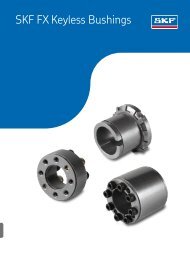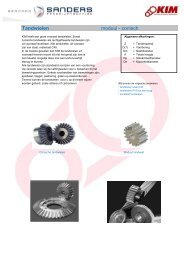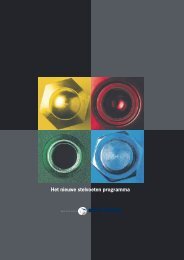Create successful ePaper yourself
Turn your PDF publications into a flip-book with our unique Google optimized e-Paper software.
Optimizing ring<br />
performance<br />
Lubrication<br />
Prior to mounting for first-time use, the<br />
S-shaped sealing grooves of <strong>NILOS</strong>-<strong>Rings</strong><br />
should be filled with grease to prevent<br />
subsequent damage to the ring’s sealing<br />
tongue.<br />
In preparing double externally sealing<br />
<strong>NILOS</strong>-<strong>Rings</strong> (AK), featuring two sealing<br />
edges, the space between the edges<br />
must likewise be filled with grease before<br />
mounting. (The type of grease used to lubricate<br />
tapered roller bearings will suffice.)<br />
If a bearing will be exposed to excessive<br />
amounts of water, the grease chamber<br />
would best be filled with a water-repellent<br />
sealing grease.<br />
After grease is applied, <strong>NILOS</strong>-<strong>Rings</strong><br />
require no further maintenance.<br />
Sealing<br />
As part of the installation process,<br />
the sealing edge of a <strong>NILOS</strong>-Ring is rotated<br />
under light pressure against either the<br />
inner or outer ring of the bearing. (This is<br />
known as run-in or groove-forming.) This<br />
rotation creates a shallow groove (or miniature<br />
labyrinth) in the hardened bearing<br />
ring, which inhibits loss of bearing grease<br />
and prevents penetration of debris.<br />
If a design permits, inner-sealing <strong>NILOS</strong>-<br />
Ring types offer particular advantages:<br />
Their sealing edges are relatively smaller<br />
(for optimum fit) and the position of sealing<br />
edges with regard to centrifugal force of<br />
lubricant will prove highly favorable.<br />
Concentric location<br />
In order for the miniature labyrinth groove<br />
to form during run-in, the sealing edge of<br />
the <strong>NILOS</strong>-Ring must run precisely concentric.<br />
With externally sealing rings (AV types),<br />
users should fit the bore of the ring closely<br />
to the shaft; with internally sealing rings<br />
(JV types), users should locate the outside<br />
edge of the ring centrally within the bearing<br />
casing hole. In either case, the locating diameter<br />
should not be proximate to keyways<br />
or grooves and the inner and outer edges<br />
of a ring’s inside recess should not be on<br />
(or in) threads, thread runouts, pushed-up<br />
sections, or hollow sections.<br />
Space requirement (h 1 )<br />
An often-cited benefit of <strong>NILOS</strong>-<strong>Rings</strong><br />
is that they require minimal space to install,<br />
whose parameters can be calculated quickly<br />
and easily.<br />
Referring to dimension tables, installation<br />
height (h) represents the overall height<br />
without affecting sealing action and h + 1<br />
mm represents the space required to mount<br />
the ring. Adhering to this formula can eliminate<br />
the possibility of ring distortion upon<br />
installation.<br />
Slip-proof clamping<br />
Ring design and installation procedure<br />
offer certain safeguards to prevent rings<br />
from turning in service. The shaft collar of<br />
externally sealing types (AV) is designed to<br />
fit snugly against a bearing to promote slipproof<br />
clamping. For internally sealing types<br />
(JV) users can rely on installation clamping<br />
elements.<br />
Space requirements<br />
h<br />
D<br />
c<br />
i<br />
h 1<br />
Run-in groove after 24 hours<br />
s<br />
Application notes<br />
<strong>NILOS</strong>-<strong>Rings</strong> can seal self-aligning or<br />
spherical (barrel-type) roller bearings only<br />
when the bearings are utilized for their high<br />
load-carrying capacities and never when<br />
misalignment may be a factor.<br />
In applications utilizing cylindrical bearings<br />
without rims (or flanges) LSTO-type sealing<br />
elements are recommended, since they can<br />
accommodate axial shifts to a maximum<br />
of 0.3 mm. (LSTO types are profiled in a<br />
separate section of this catalog.)<br />
3







